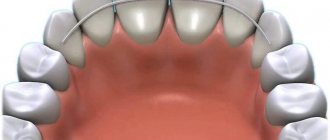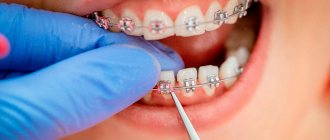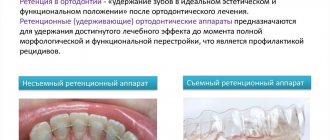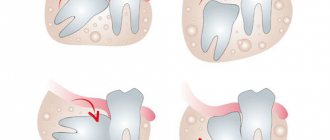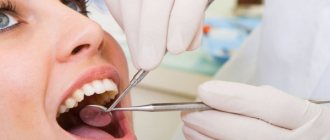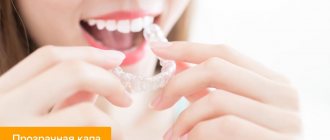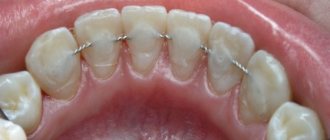This is a headache and a nightmare for any orthodontist: a patient who has had his braces removed and given a removable retainer and instructions for its use returns after some time with complaints about the curvature of his previously straight teeth. The retention period is the most psychologically difficult part of the treatment. Everything is already perfect, and then you have to wear a retainer. Yes, there are other reasons for the unsuccessful outcome of the correction. And although they are much less common, let’s talk about them in more detail.
Correction principle
The method of correcting malocclusion with braces is based on the principle of creating constant pressure on the teeth. Under pressure, the tooth root begins to press on the socket on one side, thereby causing rarefaction of the bone tissue. In the direction of rarefaction, the tooth moves. On the other side of the hole, bone tissue, on the contrary, grows. Thus, after a certain period of time, not only the position of the tooth changes, but also the shape of the socket, which prevents the tooth from returning to its original place.
Correct your bite or dental defect with invisible aligners Find out what it is
Bone tissue grows quite quickly, but it takes quite a long time to “ripen”. That is why, after finishing wearing the brace system, a removable retainer is made for the patient for another year or two or a splint is installed on the incisors and canines. Additional fixation during the retention period helps to avoid repeated tooth curvature.
Why do teeth return to their previous position?
The return of teeth to their original position can be observed for several reasons. If the patient refuses to wear retainers or use these devices contrary to the current rules. This violation occurs in removable structures. It is recommended to remove them only during meals and when performing hygiene measures. Gradually, the patient will wear retainers less and less often, up to several hours a day, and subsequently abandon them completely.
People who neglect the advice of specialists, as a rule, these are children, experience difficulties in the future, and in especially serious cases, their braces are re-installed. It is also important to remember that the slightest cracks, deformations or breakages of braces, and subsequently retainers, can lead to complications in the form of a lack of results in correcting the bite.
The second reason, also quite common, is the incompetence and low qualifications of the orthodontist. In this case, you should immediately protect yourself and your child by contacting an experienced specialist and a good clinic. It is important that the specialist knows how to use special equipment and has experience in installing braces. It is also important that the devices that will be installed on the patient’s teeth must be of the highest quality. This can be an additional guarantee of good quality of future structures, and will allow you to quickly correct the patient’s bite or other anomalies.
Possible problems after removing braces
Some people's teeth diverge quickly after completing the correction stage. During the first year, some individuals may only slightly rotate around their axis. Everything is individual, but some general patterns can be identified.
Fanned teeth
A rapid relapse after braces are removed may be due to the following factors:
- Refusal of retainers. Patients often refuse permanent retainers because their installation damages tooth enamel. And it’s annoying to wear removable retainers, even those that are worn only at night. As a result, the teeth return to their previous position, since the new position has not yet been “overgrown” with bone tissue.
- Individual characteristics. There are people in whom new formation and “maturation” of bone tissue proceeds faster than others. And there are those for whom this process is delayed. For some, the displacement of teeth in order to correct the shape of the dentition was insignificant, while for others the tooth “came a long way” before taking its place in the dentition. Teeth quickly “huddle together” after crowding is eliminated. The teeth, which were mixed with braces around their axis, easily turn back.
- Breakage of braces, use of a system of inadequate quality. If the pressure on the teeth during correction was not constant, then the likelihood of an unfavorable outcome increases. You shouldn’t walk around with a broken arch or unstuck locks for a week. It is better to see a doctor on the same day. This will save you from many problems.
- Tooth extraction. When there is not enough space for teeth in the dentition, the orthodontist may decide to remove the “extra” ones. Most often these are fours, eights, less often sixes. The absence of fangs can cause the formation of a diastema. Removing a six causes significant displacement of adjacent teeth.
Loose teeth after braces
Occurs infrequently. In most cases, the feeling of excessive tooth mobility after removing braces is deceptive. It may appear at the very beginning of the retention period and disappear on its own and without treatment. It's another matter if the teeth are really loose. In this case, it is better to seek help from a specialist.
Pain in the teeth and gums
There may be some discomfort after removing braces. Pain occurs especially often after eating solid foods. The reason for this is a change in the condition of the ligaments that hold the roots of the teeth, as well as an increase in the sensitivity of the enamel if the remineralization procedure was not carried out. Reducing the chewing load and using special medications that reduce the sensitivity of teeth and gums help reduce pain.
Signs of pathology
Incorrect distal bite is conventionally divided into 2 types based on its characteristics. These are facial and intraoral changes. Their most severe severity is observed in adults in the complete absence of treatment.
Facial manifestations of distal occlusion:
- Violation of facial proportions - asymmetrical displacement of the lower jaw back and a small, sloping chin.
- A noticeable state of always half-open mouth.
- Change in the natural shape of the upper lip - reduced in volume, upturned or very short.
- Deformation of the lower lip.
- The teeth of the upper jaw are more developed than the lower jaw, the central upper incisors protrude strongly forward.
- Sharply defined chin fold.
Such changes in the shape of the face negatively affect the appearance, the face becomes bird-like.
Intraoral signs of a distal anomaly are as follows:
- There is no closure between the lower and upper jaw.
- The teeth of the upper frontal group are noticeably moved forward.
- The lateral teeth are located abnormally relative to each other.
In most cases, distal occlusion is formed against the background of other pathologies - diastema, trema, open or crossbite.
Retention period
What a retention period is has already been discussed above. One has only to add that in orthodontics, two types of devices are used to consolidate the result of bite correction - removable and non-removable systems. What is their difference, you can find out below.
Removable retainers
Restoring structures of this type are made of plastic. They can be transparent or colored. Special mouth guards are provided for both one jaw and two rows of teeth at the same time.
Depending on the anatomical characteristics of the patient, a metal wire can be built into the design, which prevents deformation of the product and increases the efficiency of its operation.
Retention aligners do not create any difficulties in care. All that is required from their owner is cleaning the internal and external surfaces with toothpaste and a brush during daily hygiene procedures.
In addition, the removable design has the following advantages:
- do not create discomfort during operation;
- it is possible to remove the device from the mouth at any time, in case of urgent need;
- in the future, the patient can wear the structure for only a few hours a day.
If we talk about the disadvantages, we can highlight the following negative aspects of removable retainers:
- low level of aesthetics, mouthguards cannot be hidden from others;
- the presence of a foreign body in the mouth provokes increased salivation;
- Speech defects may occur during operation.
In addition, not all patients can wear a plastic product. Individual intolerance to the material can cause an allergic reaction or cause irritation of the mucous membrane.
Fixed retainers
In the production of structures of this type, durable and more hypoallergenic metal wire is used. The non-removable product attracts patients with its high level of aesthetics, since it is installed on the inside of the dentition.
Unlike removable mouth guards, the system cannot be installed or removed by yourself. The procedure is performed only by an orthodontist. The metal wire is attached to the tooth enamel using a special glue that ensures adhesion between the two surfaces.
Before starting to consolidate the result of bite correction, the specialist eliminates all problems of the oral cavity. After all, often during the period of wearing braces, tartar and bacterial plaque form on the enamel, and caries develops.
The orthodontic device is invisible to others and has the following advantages:
- Fixed retainers cannot be lost;
- they do not create a feeling of discomfort. The adaptation period lasts no more than a month;
- the impact on the teeth is continuous.
However, the metal product also has negative sides:
- the need for frequent visits to the orthodontist in order to monitor the process of consolidating the result;
- having difficulty brushing your teeth;
- the possibility of the wire coming off.
Sometimes, if the anatomical features of the oral cavity allow, experts offer patients to combine two types of retainers. For example, a non-removable structure is installed on the upper jaw, and the lower jaw is covered with removable aligners.
Braces hurt the oral cavity, what should I do?
After installing braces, each patient receives wax for locks from the orthodontist. At the very beginning, it is worth applying it to the entire system, because the mucous membrane in the oral cavity is not yet accustomed to contact with foreign objects.
Abrasions and wounds heal very quickly. Their healing can be accelerated by using agents that promote the healing of wounds in the oral cavity.
What are the advantages of ligature-free braces? And do they exist?
Ligatures are wires or elastic rings with the help of which bracket locks are attached to the arch. In ligature-free bracket systems, the arch is inserted into a special clip, and ligatures are not needed.
Self-ligating braces (also known as self-ligating braces) have been aggressively promoted for some time, causing their prices to rise. However, time and practice have shown that the advantages attributed to such systems are absent (including the myth about the special strength achieved due to minimal friction of the archwire with the bracket locks).
Proper care will protect against loose teeth
One of the causes of loose teeth is periodontal tissue disease. To prevent their development, you need to properly care for your mouth while wearing an orthodontic appliance.
Proper care involves daily brushing of teeth with 3-4 types of brushes - regular, special orthodontic with a V-shaped bristle, single-tuft and brush-brush. These devices are used alternately, gradually removing all dirt and plaque. After brushing your teeth, you need to clean the interdental spaces using superfloss - a special orthodontic dental floss. At the final stage, the oral cavity and the braces system are cleaned using an irrigator. This device directs a powerful stream of water, which removes dirt from interdental spaces, periodontal pockets and other difficult areas. To care for braces, it is important to purchase irrigators with special orthodontic attachments.
Careful and regular oral care will prevent pathological loosening of teeth under braces and avoid their loss.
What complications can there be?
If an adult or child has developed a distal bite, treatment will help avoid the consequences of pathology. In the absence of correction, the following complications are possible, which are dangerous to health:
- problems with diction, speech defects arise, correctly constructed speech becomes impossible;
- dysfunction of chewing and swallowing food;
- disruption of the proper functioning of the respiratory system;
- the appearance of dental diseases - caries and stomatitis develop;
- rapid wear of teeth, which leads to their premature loss;
- the formation of complexes due to unsightly appearance.
Malocclusion affects a person’s entire life, causing psychological problems and the development of an inferiority complex. People with this problem are often unhappy and lack self-confidence. Only correction will help improve your condition and appearance.
Classification of pathology
The following types of prognathic occlusion are distinguished:
- First type. Characterized by underdevelopment of the lower jaw. At the same time, the upper one, in its anatomical structure, develops in accordance with age.
- Second type. It is characterized by excessive development of the upper jaw along with the teeth, while the lower one is formed normally.
- Third type. In this case, changes of the first two types are combined.
- Fourth type. Involves the advancement of the front teeth of the upper jaw, which is insignificant.
Orthodontists also use the Angle classification of prognathia:
- 2 class 1 subclass. It is characterized by a narrowing of the dentition on the sides, and the front teeth of the upper jaw are fan-shaped. There is a sagittal fissure.
- 2nd class 2nd subclass. The lateral teeth are turned along their axis and deviate towards the lips, the upper front teeth tilt towards the palate. There is no sagittal fissure.
Types of retainers
Read more about the types of retainers.
Fixed.
Made of metal, they look like a strong metal arc. The fastening comes from the inside of the teeth, the design is invisible to others. In most cases, they are attached using a composite material, without sawing a groove on the teeth. If the patient has signs of periodontitis, then the arch needs to be fixed in the groove. This prevents stress on the gums.
Removable
– retention aligners, similar in appearance to aligners, and will be familiar to those who have straightened their teeth with aligners. They differ in impact. The purpose of aligners was to correct the bite by acting on the dentofacial apparatus. Retention aligners are used to consolidate the result obtained and do not exert pressure that changes the bite. The mouthguard keeps the teeth in the correct position. Muscles and ligaments learn to maintain straight teeth without the influence of the orthodontic apparatus.
How many hours a day you need to wear mouth guards is determined individually. Some patients need to wear it constantly, taking it off only when eating. For others – within 10 hours. It is necessary to care for the mouthguard, clean it and rinse it. After six months, the doctor evaluates the result and can reduce the time you wear the aligners. It is important to follow the recommendations exactly to achieve good results.
Do braces damage enamel and lead to caries?
No, the tight fit of the braces completely eliminates the penetration of food debris and microbes into the tooth; Dental enamel glue used in practice is harmless, moreover, it contains the useful element fluorine. The brace-lock even protects the tooth in a certain way.
But improper care of braces is really fraught with trouble: oral hygiene after installation of an orthopedic structure requires more attention and responsibility due to the increased accumulation of plaque. And where there is plaque, there is caries!
Why do teeth wobble under braces from an anatomical point of view?
Teeth are made up of two main parts—the dental crown (the visible part) and the root. They are connected to each other by a ligament supported by bone tissue. Under the pressure of braces, the tooth tilts, as a result of which the distance between the ligament and the dental crown changes: on the one hand it becomes larger, and on the other, on the contrary, smaller. Special cells - osteoblasts - begin to actively work and restore the missing bone tissue to create a new support for the tooth. Other cells—osteoclasts—perform the opposite job: they promote the resorption of bone tissue where the tooth needs to be moved.
In this way, the pinched connective ligament gradually straightens out, and the tooth can take its correct position. Such cycles of loss and growth of bone tissue are repeated many times during orthodontic correction, contributing to the gradual correction of the dentition.
But the speed of these processes is different: bone tissue is absorbed faster than it grows. This is the main reason why teeth become loose after braces start working.
How long does it take to install braces?
The process of manufacturing and installing braces usually takes about a week and includes the following steps:
- drawing up a treatment plan: for a more accurate assessment of the patient’s dental system, the doctor does a computed tomography scan, prepares impressions of the jaw and, together with the patient, selects the optimal type of brace system.
- Complete sanitation of the oral cavity: at the initial stage it is necessary to remove carious lesions and eliminate inflammation. If the doctor understands that some teeth will interfere with the necessary displacement of the dentition, they are removed.
- Manufacturing of braces: at this stage, laboratory specialists select template designs or manufacture individual bracket systems.
- Installation: braces are fixed on the surface of the teeth using a special fluoride-containing glue and adjusted to all parameters.
Of course, it will take a week to get used to braces. After installation, the doctor will tell you in detail how to properly care for them, what food you will have to give up during the treatment period, so that the tooth enamel under the braces does not break down and lose its natural color.
If you decide to install classic ligature braces, be prepared to visit the orthodontist approximately once a month, during these visits the doctor will manually change the position of the metal arch.
What material for braces should I choose?
Modern braces systems can be not just functional, they can be aesthetic, stylish, bright or transparent. This is possible thanks to the use of materials with different properties: plastic, ceramics, sapphire, simple or precious metal
. The properties of the listed materials are different; the choice of a specific one depends on the age of the patient, his preferences regarding aesthetics and structural strength, as well as financial possibilities.
| ceramics | metal | sapphire |
If you need a quick and inexpensive correction, you can opt for a metal structure; if long-term correction is expected, and the patient’s lifestyle requires publicity, it is worth considering ceramic or sapphire braces.
Which systems are better - with or without a ligature?
There is no clear answer to this question. From an aesthetic point of view, the best ones are those without ligature. For example, the H4 self-adjusting bracket system (OC Orthodontics) is considered one of the most aesthetic, and due to its variability and low profile, also the most effective.
It is important to understand that the main task of any brace system is to straighten the dentition and correct the bite, therefore, to correct uncomplicated anomalies, a system without a ligature is suitable, but to eliminate serious defects you will have to choose a traditional ligature design.
Only a competent orthodontist can choose the ideal braces for a patient, taking into account his individual dental characteristics, age and lifestyle.
How often should inspections be carried out?
Every 1-2 months, it all depends on the defect and the individual structure of the patient’s teeth. During the visit, the orthodontist checks the success of the treatment and sets a vector for the arch, which determines the movement of teeth in the right direction.
Missing follow-up visits may negate the effect of previous treatment. You are also required to visit a hygienist every six months.
Braces, whether external or internal, need to be worn for an average of 1.5 years. But determining more precise timing depends on the initial situation and age of the patient. Sometimes it takes 2 years to eliminate a defect.
Changes in the mouth while wearing braces
Installing a brace system to correct a bite or straighten teeth is almost always accompanied by an adaptation period. In some patients it can be several days, in others - a couple of weeks, it depends on the individual characteristics of the body. During the adaptation period, elements of the orthodontic structure can rub the mucous membrane, lead to the formation of ulcers on the inside of the lips and cheeks, and cause discomfort. Patients are warned about possible temporary disturbances in diction and difficulties in pronouncing certain sounds.
But practice shows that many are not prepared for the loosening of their teeth while wearing braces. If a tooth is loose under braces, there is a fear of losing it. Is it really possible to lose loose teeth on which braces are attached? In most cases, unusual mobility is normal and, as long as your dentist recommends it, will not lead to tooth loss.
